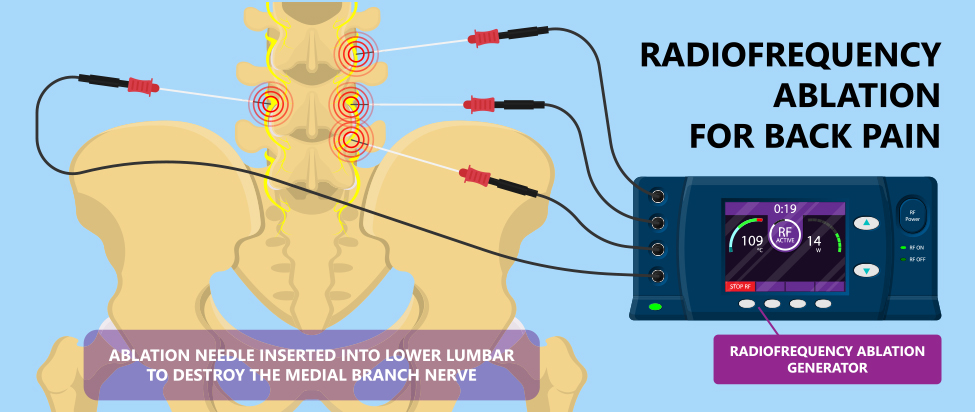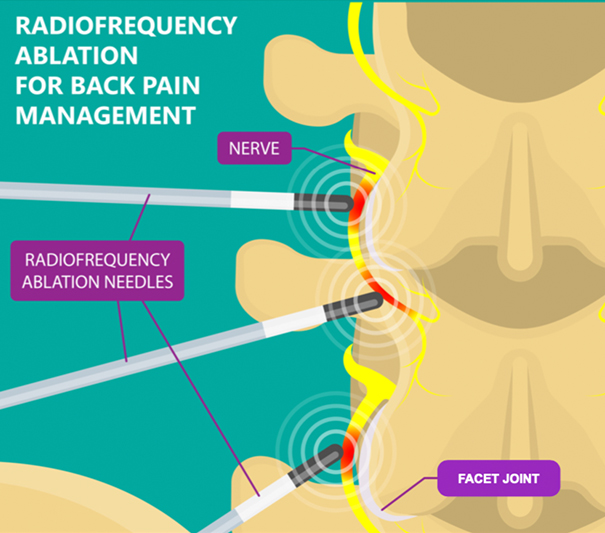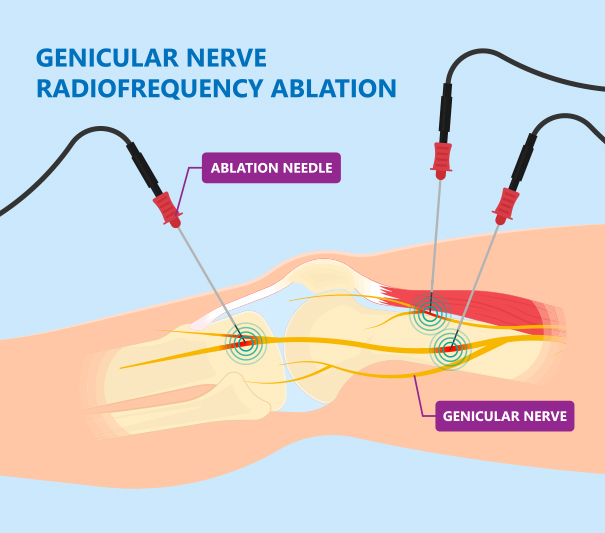RADIOFREQUENCY ABLATION (RFA / Rhizotomy)

Radiofrequency Ablation (RFA), also known as rhizotomy, is a minimally invasive nonsurgical procedure that uses a special frequency of radio waves to stop the transmission of pain. Radiofrequency waves ablate and essentially turn off the nerves that transmit pain signals to the brain. This procedure can be highly effective in treating many types of chronic pain, especially back pain and arthritis pain.
Some of the benefits of radiofrequency ablation include:
- Immediate long-lasting relief
- No surgery
- No down time
- Getting off of pain medications
- Improved physical functioning
- Quicker return to work and activities

Who is a Candidate for Radiofrequency Ablation?
Some of the chronic painful conditions that can be successfully treated with radiofrequency ablation include:
- Back Pain
- Neck Pain
- Joint Pain
- Arthritis of the Spine (Spondylosis, see Lumbar Facet Syndrome)
- Lumbar Facet Syndrome
- Cervical Facet Syndrome
- Sacroiliitis (see SI Joint Pain)
- Thoracic Pain
- Pelvic Pain
- Peripheral Nerve Pain
Prior to recommending radiofrequency ablation, the doctor will first take a detailed history and perform a thorough physical exam. Various diagnostic testing such as X-ray, MRI, or CT scans may be utilized to gain a better understanding of the location and severity of the problem.
RFA for Knee Pain

What to Expect?
The first step in the process involves a diagnostic peripheral nerve block (injection). This involves injecting a small amount of anesthetic (numbing agent) next to the nerve that is the source of the pain signal. If there is successful pain relief following the peripheral nerve block, the patient is considered a good candidate for radiofrequency ablation.
During the radiofrequency ablation procedure, X-ray guidance (fluoroscopy) is used to safely guide the specialized needles to the precise location of the nerve. Testing is done as an extra safety measure to ensure that only the correct nerves are treated. Once the precision and safety are confirmed, the radiofrequency waves are transmitted through the probes within the specialized needles which ablate and block the pain signals.
After the procedure it is common to have some soreness in the area for a few days. Many patients have nearly immediate pain relief and are back to work and their usual activities within 24-72 hours. Pain relief is typically experienced within 10 days but may take longer for some. The pain relief typically lasts between 9 months to over 2 years, depending on how long it takes for the small piece of the peripheral nerve to regenerate. Fortunately, if the same pain returns, the process may be repeated for long lasting relief!
DISCLAIMER: The information contained on this website does not constitute medical advice and should not be used as a substitute for medical evaluation, diagnosis or treatment. This website is for informational purposes only. This website and any communications sent therein do not establish a doctor-patient relationship. Although we attempt to provide accurate and up-to-date information there may be errors or inaccuracies. A proper diagnosis and treatment plan cannot be made without consultation with a doctor. Every patient is different. Please schedule an appointment should you wish to be evaluated. If you think you may have a medical emergency, immediately call 911


